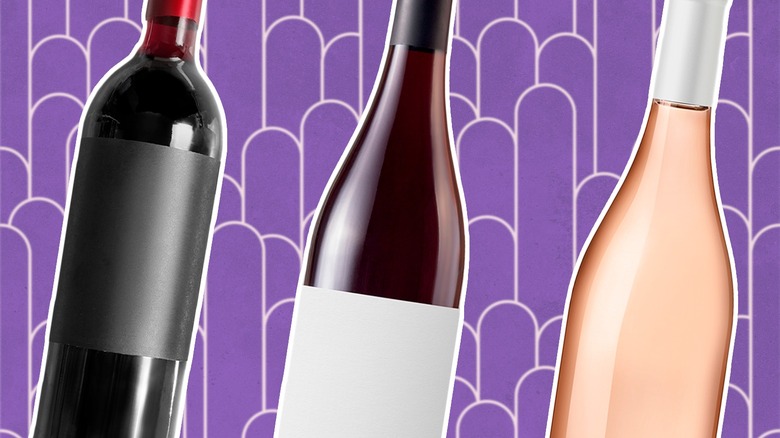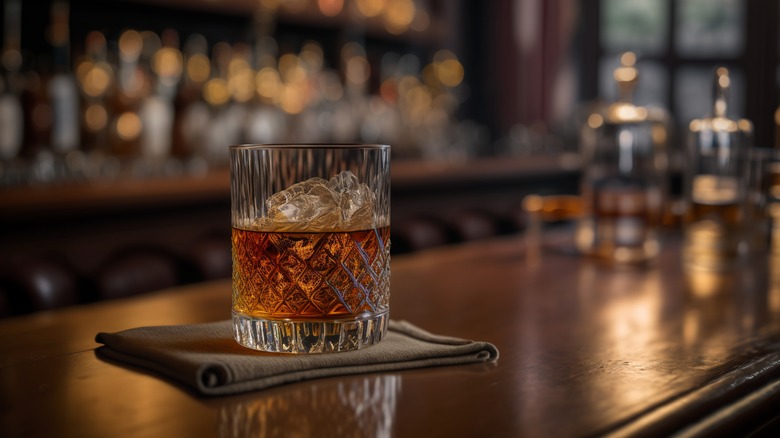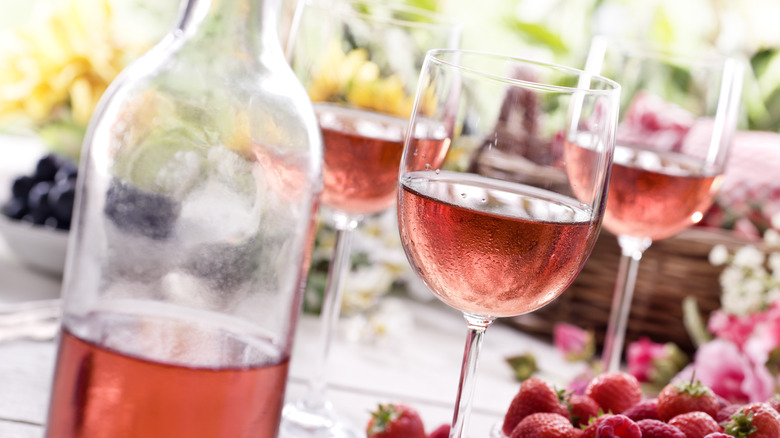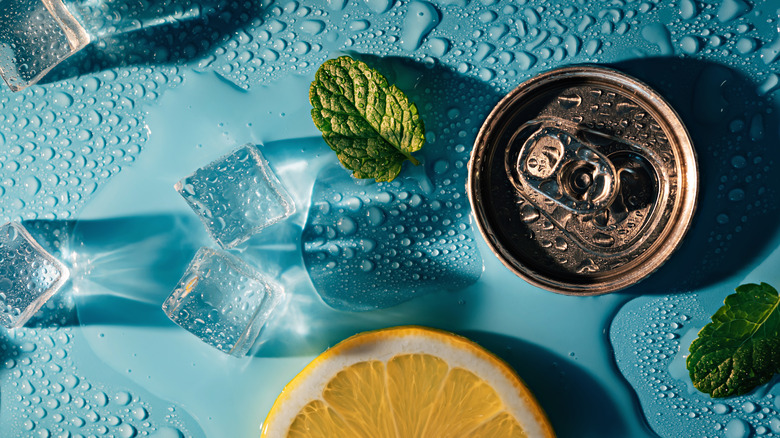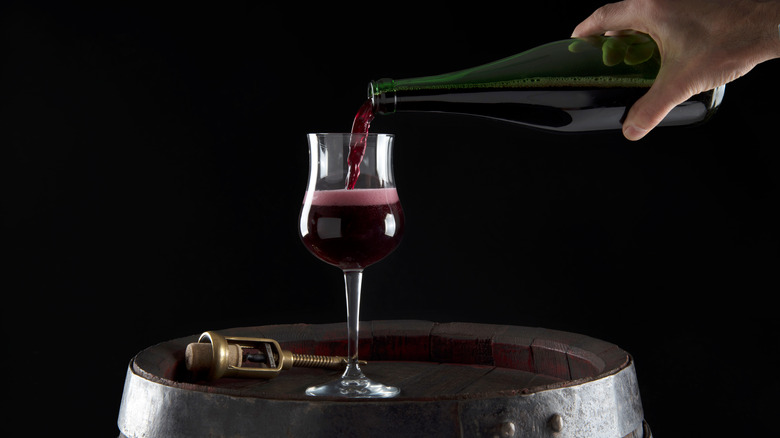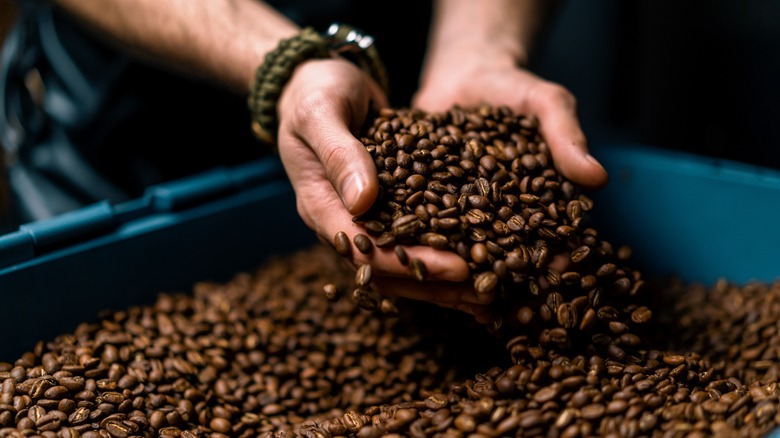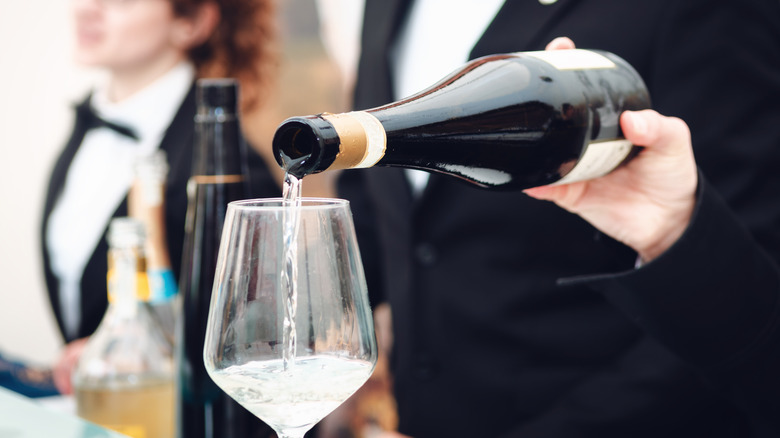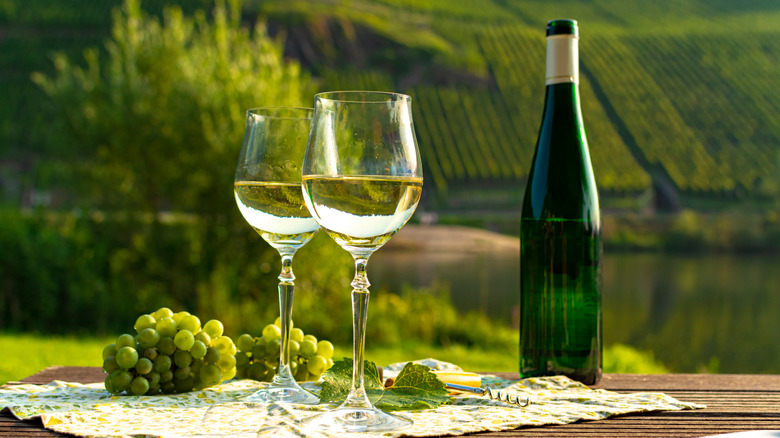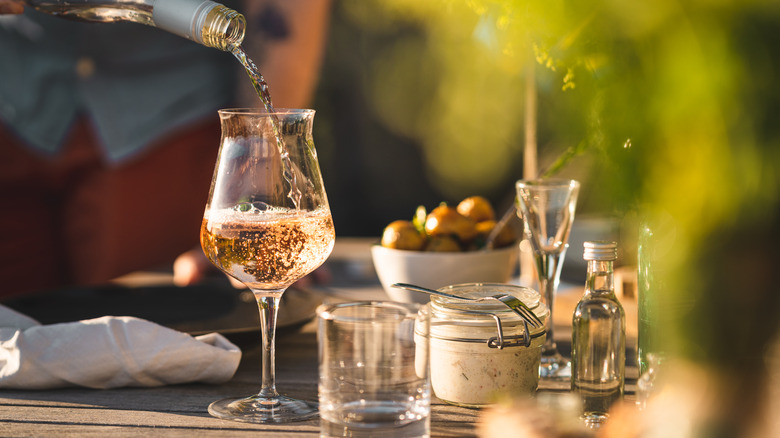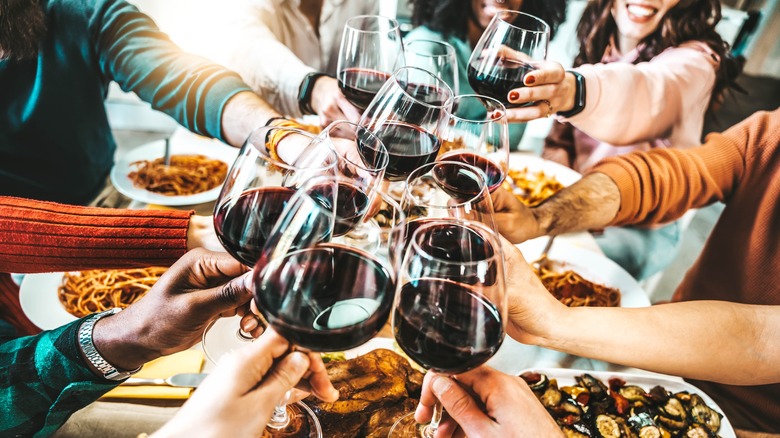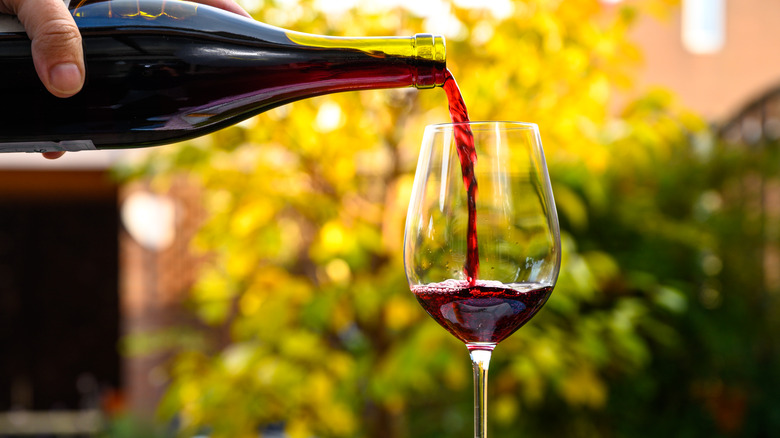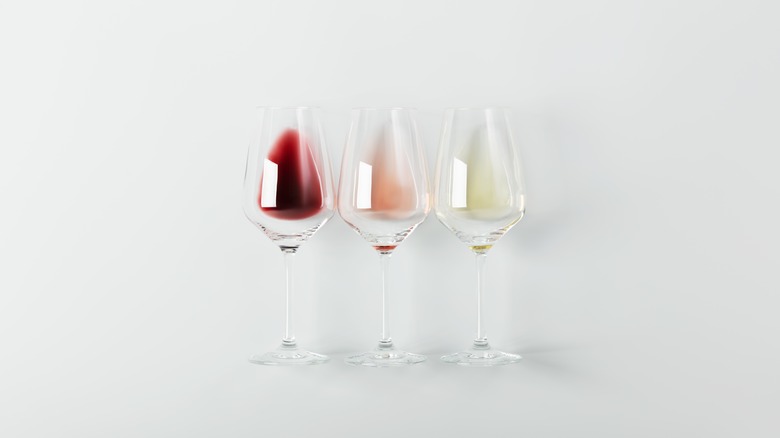24 Wines To Try If You Don't Like Wine (Yet)
Wine is truly a global phenomenon: It's cultivated on every continent, even Antarctica. But it's hard to find something you love by closing your eyes and pointing at the menu at your local sports bar. If you're not sure you like wine but are willing to give it a try, we're here to help you find a glass you just might love — no sommelier certification required.
As the former owner of a restaurant that had a wine list focused on boutique wines, I've tasted my fair share and helped many guests find their perfect glass. Believe me: No matter your preferences, there's a wine out there for you. And since every person's palate is different, I've called on other industry experts to offer their insight. Nick Leo, owner of the natural wine bar and shop The Cave in Des Moines, Iowa, and Sara Knight, a certified sommelier in Vail, Colorado, are both pros who pride themselves in decoding peoples' tastes and matching every drinker with their ideal wine. So, if you are ready to branch out, these are the wines to try based on things you already love, want to avoid, or your environment.
For craft beer and cider lovers: pét-nat and orange wine
At the core, wine is a craft product that's lovingly grown and carefully produced, just like the beer at your local microbrewery. Jumping from beer to wine may seem like a leap, but with the right one, it's just a little hop. This is where pét-nat wine comes in. Sara Knight described it as a "less sparkly" sparkling wine similar to beer. Knight said, "Like beer, the second fermentation happens in the bottle, often giving it a little more body and grit, like craft beers."
If that sounds right up your alley, head to your local wine store to ask a knowledgeable shopkeeper to point you toward the right flavor profile. If your choice of beer is funky and sour, try orange wine. "This is white wine made like red wine, incorporating the skins of the grapes to add texture, flavor, and oomph," Knight explained.
Not only do the seeds and skins give color, but they impart flavor, tannins, and acidity. "It's a wide spectrum because it's more about the process than a flavor profile, but generally speaking, the maceration of skins increases the texture and aromatic levels of a wine," said Nick Leo, who has found that beer lovers at his wine bar have turned into orange wine fans.
Ask for an orange wine with herbaceous, savory, and citrusy notes to mimic the hops in your favorite IPA or the juiciness of your go-to cider.
For whisky lovers: Rhône reds, volcanic wines, and vermouth
Whisky, bourbon, and Scotch are known for their robust flavor, where spices, vanilla, and herbal notes abound, so when you're ready to swap them for wine, look for spicy, aromatic reds. You can't go wrong in France's Rhône Valley, which houses grapes like syrah, grenache, and mourvèdre. "The Rhône Valley in France produces some of the best earthy, leathery, spicy, yet dark, big wines with a great amount of fruit and structure, too," Sara Knight said. Sounds like an aged single malt, right?
On the other hand, Nick Leo suggested scotch drinkers check out wines grown in volcanic soil, which gives the wine a smoky quality. The smoke level will vary from wine to wine, but major volcanic wine-growing regions include the Canary Islands, Sicily's Mount Etna, and the Willamette Valley. Or go with Spanish vermouth. "[We] serve it over some ice with an orange slice and a skewer of a few olives," Leo said. You'll find woody, herbaceous, citrusy, sweet, and acidic components in the glass — just like you would in an old fashioned or a whiskey sour.
For fruity-cocktail lovers: rosé and pinot grigio
Does your drink of choice reside on the fruity end of the cocktail spectrum? You're in luck, as it's an easy shift from a watermelon margarita to a fragrant glass of wine.
A pink cocktail-drinker will love the wide variety of rosé wines on the market, as you'll find the fruity notes that you love. The grape used will impact the flavor, so if you're looking for something fruitier and sweeter, seek out a rosé of pinot noir or sangiovese. Grenache rosé brings a little more spice and zip to the party — a great option if your fruity cocktail of choice is a tiki classic.
Of course, white and red wines can bring lots of fruit flavors to the party, too. Italian pinot grigio has peach and lime notes, and New Zealand sauvignon blanc boasts notes of bright tropical fruits. On the red side of things, choose a wine that isn't too heavy. Pinot noir and gamay are both lighter reds that are juicy and easy to drink.
For hard seltzer lovers: txakoli and vinho verde
The thing that sets hard seltzer apart from a regular cocktail — aside from the convenience of single-serve cans – is that refreshing fizz. But bubbles are aplenty in the wine world, too — and we're talking more than just Champagne.
White Claw drinkers will love the easy-drinking quality and pleasing effervescent of two wines from the Iberian peninsula: txakoli from Spain and vinho verde from northwestern Portugal. Txakoli (pronounced cha-ko-lee) is a Spanish Basque Country wine that is becoming more popular outside of the region. It is bright, crisp, and super refreshing, with notes of lime and underripe berries — just like lime hard seltzer.
Vinho verde is slightly sweeter — you'll taste flavors like white melon and grapefruit — and is often easier to find at wine shops than txakoli. The super drinkable white wine has a little playful effervescent that'll remind you of your favorite can of hard seltzer. It's made from a white grape from Spain called albariño, known as alvarinho in Portugal, containing citrusy flavors, crisp acidity, and salinity.
If you're moving on from mimosas: lambrusco
Mimosas make it easy to drink wine at breakfast, but the orange juice means they're not quite cocktail hour or dinner fare. Want to keep the bubbles but try something with more food-pairing abilities? You'll love lambrusco. "I think that every place that serves brunch in the country should have a dry lambrusco," Nick Leo said. "It's frothy and low in [alcohol by volume], has fruitiness but sometimes also an herbaceous or savory quality, and it has a little tannin that can cut through anything." Whether enjoying it with French toast or a cheeseburger, lambrusco can do no wrong.
This sparkling red ranges in color, with a variety of flavors and sweetness levels to match, thanks to the different grapes that can be used to make it. Overall, lambrusco is juicy and fruit-flavored — making it a great recommendation for mimosa lovers — with flavors covering everything from watermelon and wild strawberry to cranberry and mushrooms. It's produced in the Emilia-Romagna region of Italy and pairs perfectly with other local favorites: Parmigiano Reggiano, prosciutto di Parma, and meaty ragù.
For coffee lovers: malbec and carbonic maceration wines
Just like wine, coffee has many variables — and thankfully, there's a wine to match your brew of choice, no matter how you take it. If you like an elegant, classic dark roast with lower acidity, malbec is the wine equivalent you want to reach for. Grown in Argentina and France, it is a full-bodied wine with medium tannins that's great for enjoying with food.
Argentinian malbecs feature dark fruit flavors like plum, blackberry, and black cherry alongside chocolate and leather notes. French malbecs are more savory and spicy: You'll taste leather, black pepper, and currants. A "French malbec made in stainless steel, concrete, or used oak is still going to have the flavor profile of the grape," Nick Leo said. Too much oak can mask the flavors and amp up the tannins unnecessarily.
Boutique coffee roasters feature lighter roasts to highlight the fruit flavors of the beans, and Leo said winemakers do the same thing with carbonic maceration. It highlights the fruit as opposed to the structure of the wine by allowing the juice to ferment inside the grapes before crushing, resulting in a juicy end product with minimal tannins. While there are tons of contemporary winemakers turning to this age-old process, your best place to start is with a wine where carbonic maceration is a must: Beaujolais nouveau.
If you like something sweet: off-dry moscato
"There are a lot of sweet wines on the market that don't have any acidity, so they're flabby and flat and sweet for the reason of just being sweet," Nick Leo said. But that doesn't mean you can't find a sweet wine that's delicious and complex.
Look for something off-dry, which means semi-sweet in wine terms. It's when most of the residual sugar has been converted into alcohol, but not all of it. This helps maintain the wine's fruity characteristics while also giving a bit more balance. Think about it: Even if you love sweet drinks like soda, blended coffees, or fruity cocktails, they've all got something like acidity or bitterness to balance them out. You want that in your wine, too.
Bubbles can turn your off-dry wine into a playful drinking experience. Consider moscato, the sparkling option that reigns supreme in the world of sweet wines. Made from muscat grapes, these wines are known for floral, honeyed fragrances and flavors of peach and apricot. Bottles range from sweet dessert wines to dry and musky aperitifs.
If you want something light: cinsault, garnacha, and riesling
If you aren't sure you enjoy wine, something lighter is a great place to start. Look for a wine that's less tannic and a little more fruit-forward, saving bold and thought-provoking wines for later. "[Lighter reds] tend to have higher acidity, so they can be more refreshing, versatile, and simply more fun," Nick Leo said. For example, cinsault, a red grape with berry notes, has low tannins and medium acidity.
In the same vein, Sara Knight loves garnacha, which has more of a cooked fruit profile. Both grapes are at home in the Rhône, though garnacha, also known as grenache, originates from Spain, and they make lovely, juicy rosés.
For white wine, look to riesling. "It's so versatile!" Knight lauded. It's a German classic and is also grown in France, Austria, the U.S., Australia, and New Zealand. Traditionally, riesling is sweeter to balance the wine's inherent acidity, but dry varieties are worth seeking. Flavors range from lime to pineapple and apricot, but no matter what you choose, drink it with food. The sweetness goes excellently with spicy curries and Sichuan pepper.
If it's warm: rosé and Chenin blanc
Nothing satisfies on a hot day quite like a glass of rosé. And no rosé will quench your thirst quite like one from Provence. Over 90% of vines in Provence grow grapes used to make rosé, so they know their stuff.
Provençal rosés are iconic and incredibly refreshing. Commonly used grapes include grenache, cinsault, syrah, mourvèdre, and cabernet sauvignon. These grapes produce wines with prominent notes of herbs, wildflowers, summer fruits like strawberries and peaches, and citrus — think lemon, lime, grapefruit. All that fruit is balanced out by crisp minerality, thanks to the limestone soil and sea breezes. Provençal rosés are begging to be poured in the summer.
Another goodie on a warm day is the perfectly chilled white. Chenin blanc is grown in South Africa, France, the U.S., and Argentina, and its flavor profile is as varied as its growing regions. A dryer variety might taste of quince and chamomile, while one that's sweeter will have deeper flavors of ripe pear, honey, or mango. If it is aged in oak, you'll get notes of baked apple or marzipan, too. Plus, sparkling Chenin can't be missed. It's zippy and floral and fantastic with food.
If it's cold: Chardonnay and nebbiolo
There's nothing cozier than a great glass of wine in front of a fireplace. But if you're new to the world of wine, don't jump straight to something super rich. Instead, seek out the sweet spot between approachable and warming.
Chardonnay is the perfect place to start. Chardonnay produces white wines with citrus and apple notes, but everything beyond that comes down to terroir and how the wine is produced. In France, you'll find a type of Chardonnay wine called Chablis, aged in used oak to give the wine a softness on the palate without buttery flavor. Chardonnay aged in stainless steel will maintain more acidity and crispness. American winemakers often prefer new oak, which imparts buttery flavors and sweeter aromas. Try them side by side and decide what's right for you.
In the world of red, consider Italian nebbiolo. "[Nebbiolo] can have a deeper structure — often with more pronounced oak — that could appeal to someone who wants a slow-sipping sort of drink," Nick Leo said.
How sexy is dark red fruit and leather paired with the scent of roses? But the tannins and perceived weight of the wine depend on where in Italy it's grown. Two regions you've probably heard of are Barolo, where the wine is darker and more tannic, and Barbaresco, where it's fruitier and slightly less tannic.
If you're worried about tannins: Gamay
Ask someone why they don't like wine, and there's a chance they'll tell you it is the tannins. Nick Leo blames it all on the big red wines of the 1990s. "[Those wines were] high alcohol, heavily extracted, and high tannin reds that also employ a large amount of oak influence," he explained.
It makes your mouth feel dry, and if you're not accustomed to how tannins can impact a wine, it's easy to see how they can make someone run in the other direction.
Tannins in wine come from contact with the skin, seeds, and stems, so it's nearly impossible to avoid tannins altogether. Instead of simply saying no to wine, look for a lighter wine from a fruitier grape. And nothing says light and fruity quite like Gamay.
Gamay is pinot noir's juicy, floral, and more affordable cousin. It's wildly fragrant, so be sure to sip as you go. It's also acidic, making it as food-friendly as they come. If you want to taste Gamay in its purest state, seek out Beaujolais nouveau. This is the first pressing of Gamay in the fall. The wine goes from grape to bottle in just a few weeks and is supposed to be consumed immediately. There's almost no time for tannins to develop, plus the juicy nature is incredibly approachable. This may be the perfect starter wine.
If you're sensitive to sulfites: natural wine
Sulfur dioxide is used in wine for three reasons: as a preservative, to stop the fermentation process, and to protect against bacteria. This means we can thank sulfites for the huge selection of bottles at big box stores and for giving wines a longer shelf life. But sulfur dioxide can also change the flavor of the wine, so if you want to enjoy a craft glass of wine, natural is the way to go.
"Sulfur is a natural by-product in winemaking, but in very, very tiny, tiny amounts," Sara Knight said. "Most organic/biodynamic/natural producers, however, don't add any more sulfur. ... These producers ... often don't spray pesticides or other chemicals on their crops either, which really may be more responsible for your migraine anyway."
She suggests finding a small wine shop where they carefully select their shelf products. Small family wineries and farmers usually work with smaller distributors, who in turn sell wine to those small shops — meaning you're supporting small businesses all while ensuring you're getting an amazing and possibly preservative-free product.
What to order at your local bar: French pinot noir and sauvignon blanc
A local bar is probably not the best place to try wine on a whim — that's what a wine bar is for. But if you suddenly feel the urge to swap your rum and Coke for something by the glass, here are a sommelier's suggestions.
Sara Knight said you can't go wrong with French pinot noir. "[It] doesn't have to be from Burgundy, doesn't have to be expensive, [and] doesn't have to be a recognizable brand."
French pinot noir is well-balanced, with fruity, earthy notes, acid, and subtle tannins, but it doesn't lean too hard in any one direction. Plus, it's hugely popular, so chances are you'll be able to spot one fairly easily.
If you want a white wine, keep it bright, crisp, and clean to avoid anything overly oaky or buttery if you're not sure what you like. "Touraine is my best-kept secret!" Knight revealed. "Just down the road from Sancerre and ⅓ of the price."
This wine is sauvignon blanc from the Loire Valley in France and features stone fruit balanced with notes of white limestone.
Methodology
The best way to find a wine you love is to taste a lot, and we've done just that. As wine professionals — a former restaurant owner, a wine bar owner, and a sommelier — it's our job to know what's out there and to be able to guide consumers to a glass they'll love.
It's also on us to taste and recommend things based on what the person drinking the wine will like, not just our personal tastes. A great wine professional will be able to point you in the right direction, even if it's toward something they'd never order themselves. In your quest to learn to like wine, your best bet is to find someone like us, whether it's at the wine shop down the street or your local wine bar, and ask lots of questions. And, of course, taste!
